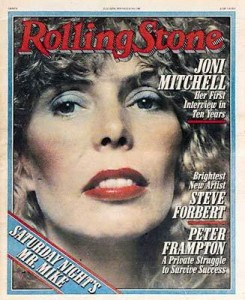“Every journalist has their dream list of interview subjects. Mine was Marvin Gaye, Neil Young and Joni Mitchell. I never got to Marvin Gaye, but Joni Mitchell more than made up for it. My last cover story for the magazine, and still my favorite. Years later, though, I was still chasing that elusive interview with Marvin Gaye. A mutual friend spoke to Gaye about it, and Gaye enigmatically sent me back a copy of What’s Going On signed in spangly colored pen. It read: ‘Dear Cameron – Keep Getting It On! Love Love Love, Marvin Gaye.’ A couple months later he was dead. Through earthquakes and rain damage, the record remains one of my most prized possessions.”
– Cameron Crowe – Summer 2000
Several days before beginning these interviews, I overheard two teenagers looking for a good party album in a record store. “How about this one,” said one, holding up Joni Mitchell’s ‘Miles of Aisles.’” “Naaaaaah,” said the other, “it’s got good songs on it, but it’s kind of like jazz.” They bought a Cheap Trick album.
When I told this story to Joni Mitchell later, I could see the disappointment flicker across her face for an instant. Then she laughed and took a long drag from her cigarette. “Here’s the thing, ” she said forcefully. “You have two options. You can stay the same and protect the formula that gave you your initial success. They’re going to crucify you for staying the same. If you change, they’re going to crucify you for changing. But staying the same is boring. And change is interesting. So of the two options,” she concluded cheerfully, “I’d rather he crucified for changing. ”
Joni Mitchell, thirty-six, has been living in exile from a mainstream audience for the last three years. Her last resoundingly successful album of new material was ‘Court and Spark,’ a landmark in poetic songwriting, performing and in the growth of an artist we had all watched mature. From folk ballads through Woodstock-era anthems to jazz-inflected experimentalism, Joni Mitchell had influenced a generation of musicians.
Then, in 1975, she released ‘The Hissing of Summer Lawns,’ her ambitious follow-up to ‘Court and Spark.’ She introduced jazz overtones, veered away from confessional songwriting and received a nearly unanimous critical drubbing. Mitchell reacted to the criticism by keeping an even lower personal profile. She spent most of her time traveling (the road album, ‘Hejira,’ was released in 1976), associating with progressive jazz artists and asking questions. With ‘Don Juan’s Reckless Daughter, ‘ a double album released in the winter of 1977, she and pop music had nearly parted ways. In a time when the record-buying public was rewarding craftsmen, Mitchell seemed to be steadfastly carrying the torch for art. Her sales suffered, but this direction was leading to a historic juncture in her career.



